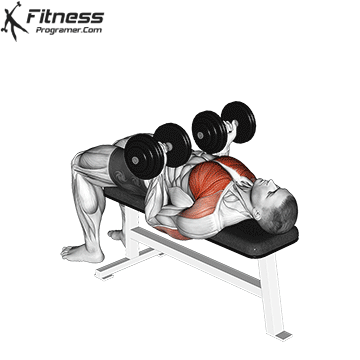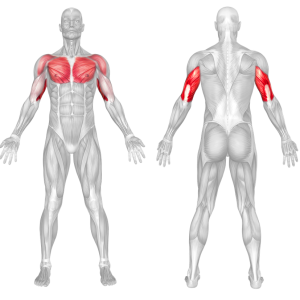Reverse Grip Dumbbell Bench Press Overview
The Reverse Grip Dumbbell Bench Press is an underrated yet powerful chest exercise that focuses on the upper chest and triceps. Unlike the traditional bench press, this variation uses a reverse grip, altering muscle engagement to provide a unique and effective workout for your upper body.
How to Perform:

Setup:
- Choose Your Dumbbells
- Select a weight that allows you to maintain proper form throughout the exercise.
- Position Yourself
- Lie back on a flat bench with your feet flat on the floor.
- Hold a dumbbell in each hand with a reverse grip (palms facing your face).
Execution:
- Starting Position
- Extend your arms directly above your chest, keeping your wrists aligned and stable.
- Maintain a slight bend in your elbows to reduce joint strain.
- Lower the Dumbbells
- Inhale and slowly lower the dumbbells toward your chest, keeping your elbows tucked at about a 45-degree angle to your torso.
- Stop when the dumbbells are just above your chest.
- Press the Dumbbells Upward
- Exhale and press the dumbbells back to the starting position in a controlled motion.
- Focus on squeezing your chest muscles at the top of the movement.
- Repeat
- Perform 8–12 repetitions for muscle hypertrophy or 12–15 repetitions for endurance.
Tips for Proper Form
- Use a Spotter: Reverse grip movements can feel less stable, so a spotter can enhance safety, especially when lifting heavier weights.
- Start Light: Begin with a lighter weight to familiarize yourself with the movement and ensure proper form.
- Maintain Control: Move the dumbbells slowly and with control to maximize muscle engagement and minimize injury risk.
- Align Your Wrists: Keep your wrists neutral to prevent strain or discomfort during the lift.
- Warm Up Thoroughly: Engage in a dynamic warm-up focusing on the chest, shoulders, and triceps to prepare for the exercise.
Common Mistakes to Avoid
- Using Too Much Weight: Excessive weight can compromise your form and increase the risk of injury.
- Flaring Elbows: Keep elbows close to your torso to prevent unnecessary shoulder strain.
- Neglecting Control: Avoid letting momentum drive the movement; slow and steady wins the race.
- Incorrect Grip Position: Ensure your grip is firm and aligned to prevent the dumbbells from shifting during the lift.
Benefits of the Reverse Grip Dumbbell Bench Press
1. Chest Focus
- The reverse grip shifts the emphasis from the middle chest to the upper chest, targeting the inner and clavicular portion of the pectoralis major. This can lead to a more defined and sculpted upper chest over time.
2. Triceps Activation
- The reverse grip increases triceps engagement due to the altered elbow path and mechanics. This provides additional strength and hypertrophy benefits, complementing other triceps-focused exercises.
3. Reduced Shoulder Stress
- By altering the arm and shoulder positioning, this grip minimizes strain on the shoulder joint. It’s a great option for individuals who experience shoulder discomfort during traditional bench pressing, allowing them to train effectively without pain.
4. Improved Muscle Symmetry
- Dumbbells require each arm to work independently, helping to address and correct muscle imbalances. Over time, this promotes better symmetry in strength and muscle development between the left and right sides.
5. Enhanced Grip Strength
- The reverse grip places a unique demand on the forearms, challenging grip strength and stability. Over time, this can lead to stronger forearms and better performance in other exercises requiring a firm grip.

